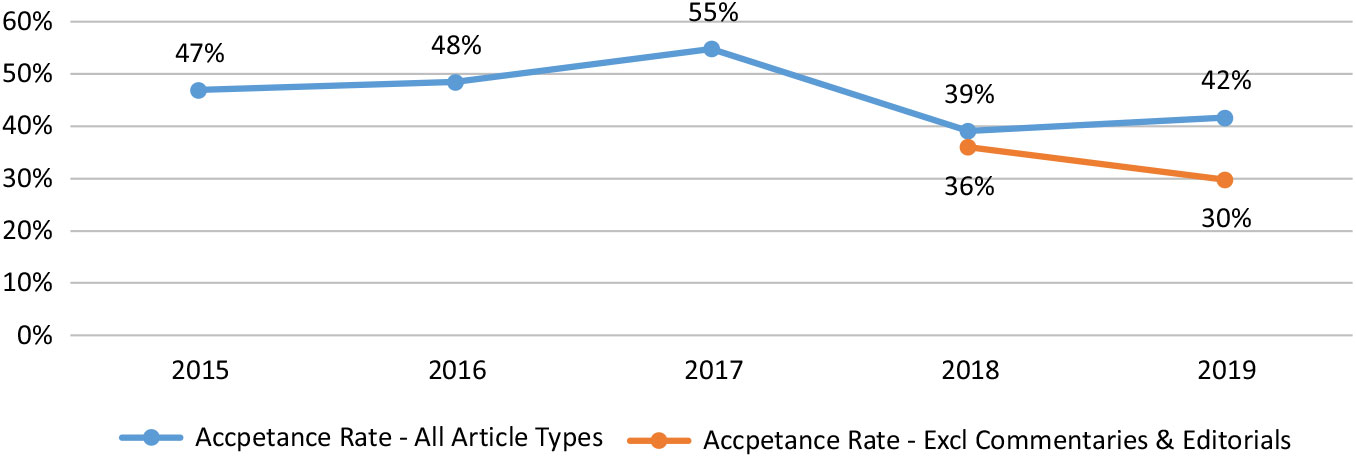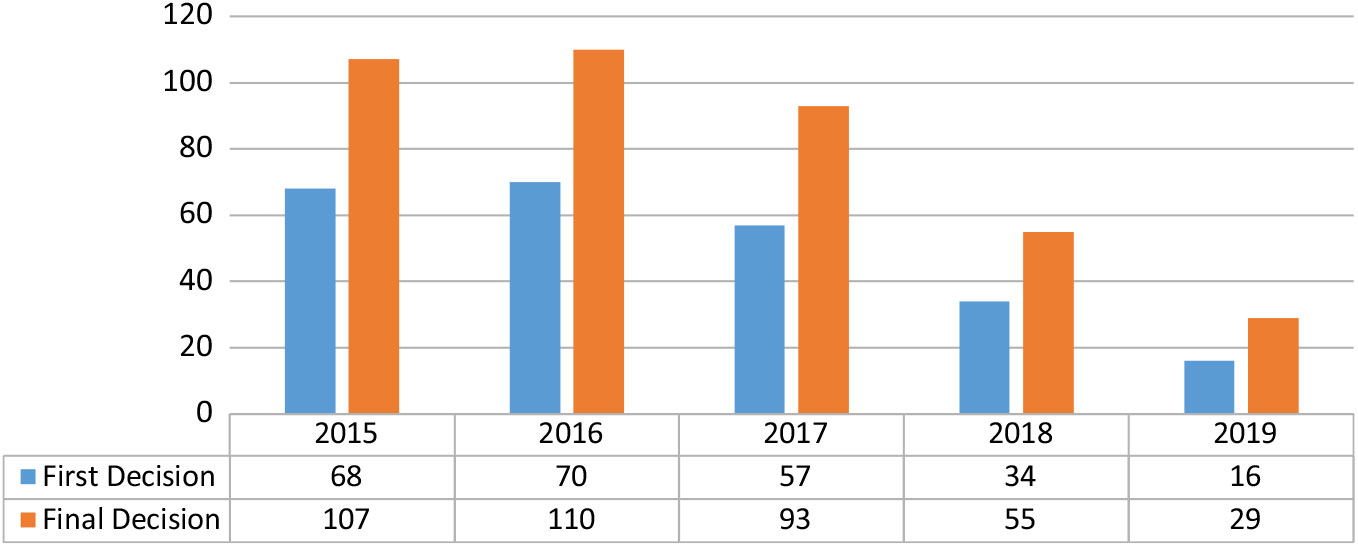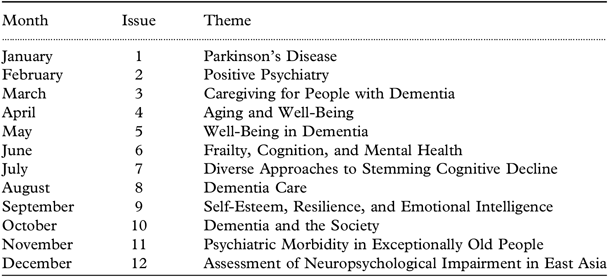The International Psychogeriatrics (IPG) is the flagship journal of the International Psychogeriatric Association (IPA). The IPA was founded in 1982. Today its membership includes physicians (psychiatrists, neurologists, geriatricians, primary care clinicians, among others), psychologists, nurses, social workers, occupational therapists, researchers, epidemiologists, and many others. With members from more than 50 countries, the IPA brings together psychogeriatricians from various backgrounds. The IPG was born in 1989 (Cohen etal., Reference Cohen, Bergener, Kazuo and Finkel1989). I feel fortunate to have been chosen to follow in the footsteps of several outstanding Editors-in-Chief (Lautenschlager Reference Lautenschlager2014). The first issue of the new Editorial Board was published in January 2018 (Jeste, Reference Jeste2018a). I am proud to say that the journal has made considerable progress during the past year, thanks to the incredibly collaborative work involving IPG Editorial Board, IPA leadership, Cambridge Press, authors, reviewers, and readers. Below is a summary of our progress as well as plans for the coming year.
The IPG reflects the global vision and mission of the IPA in being a multidisciplinary, peer-reviewed journal for researchers, clinicians, and educators in geriatric psychiatry, with a broad encompassing approach to aging, including mental and cognitive health and illnesses and taking into account biological as well as psychosocial perspectives.
The new Editorial Board includes about 30 Triage Editors from a number of countries and covering various professions. We have four Deputy Editors: Steve Arndt, PhD; Henry Brodaty, MD; Gill Livingston, PhD; and Kostas Lyketsos, MD. The Board members include several junior colleagues – fellows or junior faculty who, with mentorship and experience, will become the future leaders of our field. We count on invaluable input from numerous reviewers. Every submitted paper is reviewed by me as the Editor-in-Chief or one of the Deputy Editors. We decide if the paper is clearly suited for the IPG and whether it is of sufficiently high quality. If a paper does not meet both of these criteria, it is rejected without further external review, so the authors can quickly submit it to another journal. The small number of papers that pass the initial filter are sent out for external reviews. We typically select two reviewers for each paper, almost always including a statistical reviewer for data-based papers. Without the reviewers’ generous help, the peer-review process would not be possible.
Running a journal is a team work. The Board of Directors of the IPA, led by the IPA President (Bill Reichman, MD), plays a major role in shaping and supporting the mission of the IPG, while scrupulously avoiding even an appearance of unnecessary influence on editorial independence. Important members of the IPG team also include the staff of the Cambridge University Press, publishers of the journal, specifically Jessica Bradley, the Publishing Editor; Elaine Halls, the IPG Editorial Office Manager; Kayla Riddleberger, the Associate Production Editor; and Joon Won Moon, the Marketing Manager.
Submissions, decisions, and turnaround times
The IPG has continued to grow rapidly. The number of manuscripts received has maintained an upward trend over the past several years and is on the way to reach a new high of 500 this year – a major milestone for our journal. The submitted articles come from various countries across the globe. Table 1 provides the numbers of articles in various categories received during the last 5 years. The largest category of unsolicited articles is that of original research articles, followed by review papers. We no longer publish case reports or protocol-only papers.
Table 1. Original manuscripts received by article type, 2015–2019

To keep up with the increasing numbers of submissions and increase the quality of published papers, the acceptance rates of the submitted manuscripts have been reduced significantly. Figure 1 depicts the changing rates of acceptance of the articles during the last 5 years. This year the rate of acceptance of unsolicited articles (i.e. excluding Invited Commentaries and Guest Editorials) will be below 30% for the first time, and it is expected to decline further during the coming year.

Figure 1. Acceptance Rates, 2015–2019.
The authors of submitted new papers expect early decisions so that the accepted papers would be published and the rejected papers can be resubmitted to another journal more quickly. Therefore, we have markedly shortened our turnaround times. An important priority for us is to reduce the time for the first as well as the final decisions. As shown in Figure 2, the mean time to first decision is now 16 days, while that to the final decision is 29 days. These are among the shortest average times to decisions among peer-reviewed journals in our field. Sometimes, unfortunately, there are delays in reviews of individual papers because of difficulties in finding reviewers who are experts in the specific area, have no conflicts of interest, and are willing to review. This is a problem that practically all the medical journals are currently facing. The IPA has recently initiated a program to offer continuing education credits to reviewers whose reviews are both timely and of high quality.

Figure 2. Average Turnaround Times (Days), 2015–2019.
Monthly issue themes
One of my initiatives focuses on developing theme-focused issues of the IPG. The goal is to have several (but only a limited number of) papers on a common theme. After choosing a theme, I invite outside experts to write a Commentary on the respective article/s to highlight their strengths as well as limitations and to suggest directions for advancing research or clinical care in that particular area of work. Such theme-focused issues are highly valued not only by researchers but also by trainees and clinicians. I should add that, to ensure balance of topics, a majority of the articles published in an issue are not on the selected theme. Furthermore, we also attend to diverse themes within our field. While dementias and other neuropsychiatric disorders of late life continue to be a critical arena of clinical care, research, and education, we must also pay attention to successful cognitive and emotional aging. The themes of the issues of the IPG published from January through December of 2019 are listed in Table 2. These themes have included disorders including dementias and Parkinson’s Disease as well as positive aspects of mental health and aging such as well-being, self-esteem, and emotional intelligence. Psychiatry should not be restricted to studying and treating mental illnesses only. While treating psychiatric disorders will always be our primary responsibility, we also need to study and promote mental health, well-being, and positive psychosocial factors like resilience, optimism, wisdom, and social support – this constitutes the Positive Psychiatry of Aging (Jeste, Reference Jeste2018b).
Table 2. List of themes for monthly issues, 2019 (Volume 31)

Measures of impact
How does one measure the success of a peer-reviewed journal? While growing numbers of submissions clearly point to increasing popularity of the journal among researchers, there are other equally meaningful measures too. For me, the IPA members’ opinion about the value of their journal is critical. I am delighted to report that, in a recent survey of membership, the IPG was rated as one of the most important benefits of belonging to the IPA. There are also additional ways of evaluating a journal’s usefulness to all of its readers. These include usage statistics, Impact Factor, and Altmetric score.
Usage statistics refer to online abstract view counts, full-text (pdf or HTML) view counts, and homepage view counts. These data are recorded daily for the Journal. Table 3 includes the 20 most popular articles published in the IPG during the last year in terms of usage statistics.
Table 3. The 20 most popular 2019 articles in terms of usage

From the research perspective, peer-reviewed journals have been traditionally judged by the frequency with which the papers published are cited by various authors. The specific measure for this purpose is called the Impact Factor, which is calculated by the number of citations made in any given year to papers published in the journal within the 2 consecutive years immediately preceding, divided by the total number of eligible articles published during those 2 years. Thus, the 2018 Impact Factor for the IPG is computed as follows: Number of cites to IPG papers during 2018 to items published in 2017 and 2016 (= 917) divided by the Number of papers published in: 2017 and 2016 (= 370). The resulting number is 2.478 – that is the Impact Factor for IPG in 2018. The IPG’s Impact Factor has been increasing over the past few years, and in 2018, it was the highest it has been during the past 5 years. An examination of the previous data shows that the number of cites to recent items published in the IPG have increased by about 10%, while the number of published items has remained steady. This has resulted in a 10% increase in the Impact Factor from 2017 to 2018. Of course, there is room for further increase in the Impact Factor in the years ahead. Table 4 lists the 20 most cited papers that contributed to the latest available (2018) Impact Factor of the IPG. It may be noted that the IPG publishes more papers than any other journal in geriatric psychiatry. By lowering the rate of acceptance of articles, the quality of the remaining selected papers published in the IPG would improve further, leading to more citations of those papers and a higher Impact Factor.
Table 4. The top 20 papers contributing to the 2018 impact factor

From a broader community perspective, the usefulness of a medical journal like the IPG can also be assessed by examining the number of times it is cited in the general media (major newspapers, television, and radio) as well as social media including Facebook and Twitter. Many journals use Altmetrics to measure this type of impact of their papers, beyond citations in research journals. Altmetrics tracks the sharing and discussion around research papers through social media sites, newspapers, government policy documents, and other sources. It then uses this information to calculate a score for applicable articles. The Altmetric score is a more instant measure of a paper’s impact on the community than say a research citation count. Several papers published last year in the IPG became internationally known through their coverage in various media outlets. Table 5 lists the top 10 papers published in the IPG during all the years, which received the highest Altmetric scores.
Table 5. Top 10 papers with the highest altmetric scores, all years

Not surprisingly, several papers meet not just one but two of the three criteria for impact mentioned above: usage statistics, Impact Factor, and Altmetric score. For example, two papers on loneliness in the community which had high usage also had high number of cites in scientific journals (Cohen-Mansfield etal., Reference Cohen-Mansfield, Hazan, Lerman and Shalom2016) or high Altmetric score (Lee etal., Reference Lee2019). A paper on views about robots in people with dementia and their caregivers received high usage and also high number of scientific citations (Wang etal., Reference Wang, Sudhama, Begum, Huq and Mihailidis2017). Two papers on behavioral and psychological symptoms in dementia that had high usage scores were either cited frequently by researchers (Feast etal., Reference Feast, Moniz-Cook, Stoner, Charlesworth and Orrell2016) or by the media (Kales etal., Reference Kales, Lyketsos, Miller and Ballard2019). Another paper (Choi etal., Reference Choi, DiNitto, Marti and Choi2017) associating adverse childhood experiences with later life mental and substance use disorders had high usage as well as high number of cites in scientific journals. It should be added that typically, the number of cites in scientific journals to a published paper tends to increase over time, whereas the usage statistics and Altmetric score may not.
Plans for the coming years
The IPG Editorial team, in consultation with the Board of Directors of the IPA as well as other stakeholders, will continue to engage in a dialogue to help the journal progress further. We welcome input from the membership of the IPA and the overall readership of the IPG. Similarly, authors’ and reviewers’ comments are also very helpful.
The journal’s website is undergoing improvements and updates. Given the rapidly spreading general trend, supplemental digital content will allow the IPG to publish content online that otherwise could not be published in print. To ensure transparency regarding ethical issues and avoidance of conflicts of interest, we will publish an annual listing of all potential conflicts of interest and/or funding disclosures from members of the Editorial Board.
Our goal is to ensure that the IPG becomes and remains the leading forum for publication of cutting-edge science in aging-related mental and behavioral health and neuroscience. At the same time, the published papers must be useful to clinicians and trainees. We will also strive to maintain the international nature of the IPG, while raising the quality of the science published. I have no doubt that the best days and years for the IPG lie ahead of us.
Acknowledgements
I am personally thankful to a number of colleagues for their help with this article. I particularly want to acknowledge Jessica Bradley, the Publishing Editor of the International Psychogeriatrics, and Elaine Halls, the IPG Editorial Officer Manager, for their incredible help with the tables and figures included in this paper.









